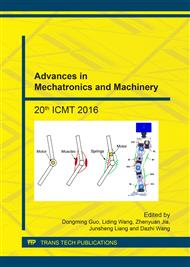[1]
R.M. White, Generation of elastic waves by transient surface heating, J. Appl. Phys. 34 (1963)3559–3564.
Google Scholar
[2]
G. Birnbaum, G.S. White, Laser techniques in NDE, in: R.S. Sharpe (Ed. ), Research Techniques in Nondestructive Testing, Academic Press, New York, (1984).
Google Scholar
[3]
D.A. Hutchins, R. J. Dewhurst, S. B. Palmer, Laser generation as a standard acoustic source in Meta, Appl. Phys. Lett. 38 (1981) 677–679.
DOI: 10.1063/1.92476
Google Scholar
[4]
C.B. Scruby, L.E. Drain, Laser Ultrasonics: Techniques and Applications, Adam Hilger, Bristol, 1990, p.76.
Google Scholar
[5]
S.J. Davies, C. Edwards, G.S. Taylor, et al., J. Phys. D: Appl. Phys. 26 (1993) 329–348.
Google Scholar
[6]
Y. Hong, S. D. Sharples, M. Clark, et al., Rapid and accurate analysis of surface and pseudo-surface waves using adaptive laser ultrasound techniques, Ultrasonic 42 (2004) 515-518.
DOI: 10.1016/j.ultras.2004.01.046
Google Scholar
[7]
A. Moura, A.M. Lomonosov, P. Hess, Depth evaluation of surface-breakingcracks using laser-generated transmitted Rayleigh waves, J. Appl. Phys. 103 (2008) (Art. No: 084911).
DOI: 10.1063/1.2910897
Google Scholar
[8]
S. Yashiro, J. Takatsubo, H. Miyauchi, et al., A novel technique for visualizing ultrasonic waves in general solid media by pulsed laser scan, NDT&E Int. 41 (2008) 137–144.
DOI: 10.1016/j.ndteint.2007.08.002
Google Scholar
[9]
Karabutov AA, Podymova NB. Quantitative analysis of the influence of voids and delaminations on acoustic attenuation in CFRP composites by the laser- ultrasonic Spectroscopy method. Compos Part B: Eng 2014; 56: 238–44.
DOI: 10.1016/j.compositesb.2013.08.040
Google Scholar
[10]
Jijun Wang, Zhonghua Shen, Ã Numerical simulation of laser-generated surface acoustic waves in the transparent coating on a substrate by the finite element method [J]. Optics & Laser Technology 39 (2007) 21–28.
DOI: 10.1016/j.optlastec.2005.05.015
Google Scholar
[11]
Baiqiang Xu etc, Thermal and mechanical finite element modeling of laser-generated ultrasound in coating–substrate system[J]. Optics & Laser Technology 38 (2006) 138–145.
DOI: 10.1016/j.optlastec.2004.12.002
Google Scholar
[12]
R.E. Challis, U. Bork, P.C.D. T Odd. Ultrasonic NDE of adhered T-joints using Lamb waves and intelligent signal Processing, Ultrasonies1996 34 455-49.
DOI: 10.1016/0041-624x(95)00115-j
Google Scholar
[13]
B. Sadoun, An emcient simulation scheme for testing materials in a nondestructive manner. Information Science 2001 137 43-51.
DOI: 10.1016/s0020-0255(01)00113-x
Google Scholar
[14]
Jijun Wang, Zhonghua Shen, etc, Numerical simulation of laser-generated surface acoustic waves in the transparent coating on a substrate by the finite element method. Optics & Laser Technology 39 (2007) 21–28.
DOI: 10.1016/j.optlastec.2005.05.015
Google Scholar
[15]
Wu L, Cheng JC, Zhang SY. Mechanisms of laser-generated ultrasound in plates. J Phys D Appl Phys 1995; 28: 957–64.
Google Scholar
[16]
Xu, Baiqiang Numerical modeling of laser ultrasound in Layered systems using finite element method and determination the materials Parameters using the neural networks [D]. Nanjing. University of Science & Technology.
Google Scholar
[17]
B. Boashash, Note on the use of the Wigner distribution for time frequency signal analysis, IEEE transaction on acoustics, speech, and signal Processing, 1988, 36(9): 151-1521.
DOI: 10.1109/29.90380
Google Scholar
[18]
Simon Haykinetc, The comprehensive basis of the neural network, the first l edition . Beijing Tsinghua university press, (2001).
Google Scholar
[19]
Martain T. Hagan. Howard B. Demuth mark H. Beale etc, Neural network design, a Beijing machinery industry press (2002).
Google Scholar
[20]
Xu, Dong, Wu, Zheng, Based on MATLAB6. X system analysis and design, a xi an- xi an university of electronic science and technology press, (2002).
Google Scholar


